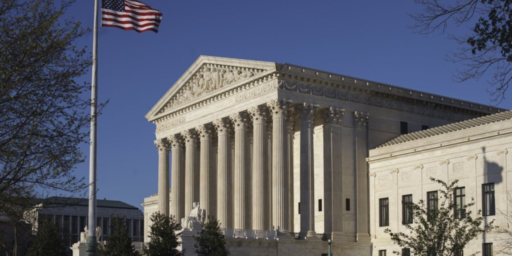Supreme Court Transforms Use of Sentence Guidelines
Supreme Court Transforms Use of Sentence Guidelines (Linda Greenhouse, NYT)
The Supreme Court on Wednesday transformed federal criminal sentencing by restoring to judges much of the discretion that Congress took away 21 years ago when it put sentencing guidelines in place and told judges to follow them. The guidelines, intended to make sentences more uniform, should be treated as merely advisory to cure a constitutional deficiency in the system, the court held in an unusual two-part decision produced by two coalitions of justices.
In the first part, five justices declared that the current guidelines system violated defendants’ rights to trial by jury by giving judges the power to make factual findings that increased sentences beyond the maximum that the jury’s findings alone would support. That portion of the opinion had been widely anticipated, growing directly out of a similar conclusion the same five justices – John Paul Stevens, Antonin Scalia, David H. Souter, Clarence Thomas and Ruth Bader Ginsburg – reached last June in invalidating the sentencing guidelines system in the state of Washington.
The real question hanging over the case, which the court granted on an expedited basis over the summer and heard in October on the opening day of its new term, was how the justices would solve the problem. So it was the second part of the decision – the remedy – that was the surprise and that will shape the continuing debate over sentencing policy. With Justice Ginsburg joining the four justices who dissented from the first part – Stephen G. Breyer, Sandra Day O’Connor, Anthony M. Kennedy and Chief Justice William H. Rehnquist – a separate coalition said the problem could be fixed if the guidelines were treated as discretionary rather than mandatory. From now on, Justice Breyer said, writing for the majority in this portion of the decision, judges “must consult” the guidelines and “take them into account” in imposing sentences. But at the end of the day the guidelines will be advisory only, with sentences to be reviewed on appeal for “reasonableness.” Lawmakers and legal experts predicted Wednesday that the court’s decision would renew the struggle between Congress and the judiciary for control over sentencing. On Capitol Hill, some members of Congress made it clear that they were bracing for a fight over how much discretion federal judges should have.
Slate’s Eric Umansky correctly calls the decision “Supremely Confusing.”
The Washington Post, Wall Street Journal world-wide newsbox, and New York Times all lead with the Supreme Court ruling 5-4 that federal judges aren’t required to follow mandatory sentencing guidelines, but still, um, “must consult” them and “take them into account.” The seemingly split-the-baby ruling came via an unusual two part decision.
[…]
The way mandatory sentences worked before, judges, without findings from a jury, were required dole out more years if there were aggravating circumstances, such as being a ringleader. One majority of Justices concluded that was unconstitutional. Another five-justice majority decided that judges should still try to follow the guidelines anyway, at least until Congress comes up with new rules. Justice Ruth Bader Ginsburg was the key to the compromise. She was the only justice who concluded that the guidelines were both unconstitutional and advisable. Apparently she was convinced by Justice Breyer, who one law prof credited with a “remarkable act of judicial jujitsu.”The Journal sees the Supreme’s decision(s) as a win for defendants. The other papers say it’s unclear how it’s going to shake out. An analysis inside the NYT says the ruling opens the door to another round of fighting on sentencing between the judiciary and Congress.
Glenn Reynolds responds with a characteristically brief
I don’t really have a lot to say besides “jeez, can’t the Supreme Court answer this kind of thing with a single, clear opinion?” Previous courts seemed to manage. . . .
He refers us to Doug Berman, who is an expert on the issue who testified before Congress last summer. He has a lot to say–it’s the focus of his blog as well as his professional study–but one paragraph stands out:
[E]veryone (myself included) should take a deep breath and not even expect to be able to figure all this out instantly. In particular, I think it is especially important for Congress to act cautiously, hold hearings, consult in an open and deliberative way with the US Sentencing Commission, the Justice Department, defense groups and judges of all sorts to chart a sound and sensible path for the future of the federal criminal justice system.
Volokher Orrin Kerr has a lengthy discussion of what he sees as the root problem with this and similar cases, namely, the court dealing with problems within the purview of the legislature through imposition of structural rules.
In Booker, the Court had to find the initial starting point for implementing the Blakely structural rule. It’s important to realize that the issue was only the starting point; one way or another, it’s the legislature that gets to implement the Court’s structural rule, not the Court. But the various opinions of the Court reflect two basic short-term approaches to implementing a structural rule change. One is to force the legislature to raise the bar: in effect, to mandate a strong level of protection across the board. That was the approach favored by Stevens, Scalia, Thomas, and Souter: they would have compelled the current sentencing regime to add protections to defendants by keeping existing law intact but just adding jury trial guarantees to all sentencing enhancements. It’s kind of like mandating that everyone be treated well in an equal protection case; the goal would have been to use the new structural rule to bolster protections.
This is a very complicated issue, no doubt. I’m not sure the Court did much to help sort it out. Sometimes, though, they don’t. If I’m understanding his point correctly, Kerr is likely right here: this is simply the nature of checks and balances. Congress has every right to set sentencing guidelines, so long as they don’t do so in a way that takes the power to decide factual matters away from juries. The problem is, it’s not always clear what precisely constitutes a “fact” in the decision-making process. I think we can safely predict more legislation and more case law on this one in the future.
Update: As one would expect, Howard Bashman has a whole lot more linkage. See here and here, especially.





This is just turf protection. The judicial clergy disliked the sentencing guidelines. Much whining occurred. Now the priests can do what they want again without having to do what the Pope (i. e. Congress) wants.
Woulda’ helped if Justice Ginsburg hadn’t written both the opinion for the court and an opinion dissenting in part. Makes it a tad bit confusing to figure out what is what.